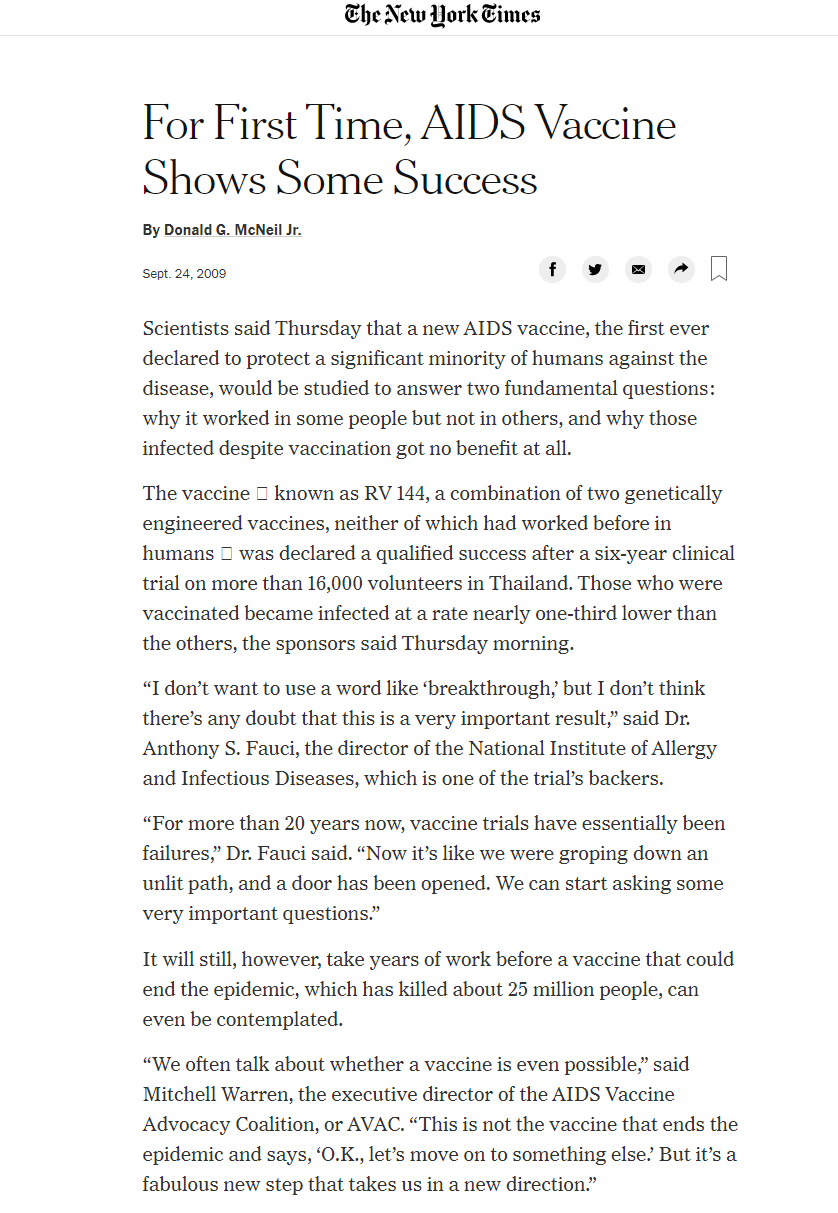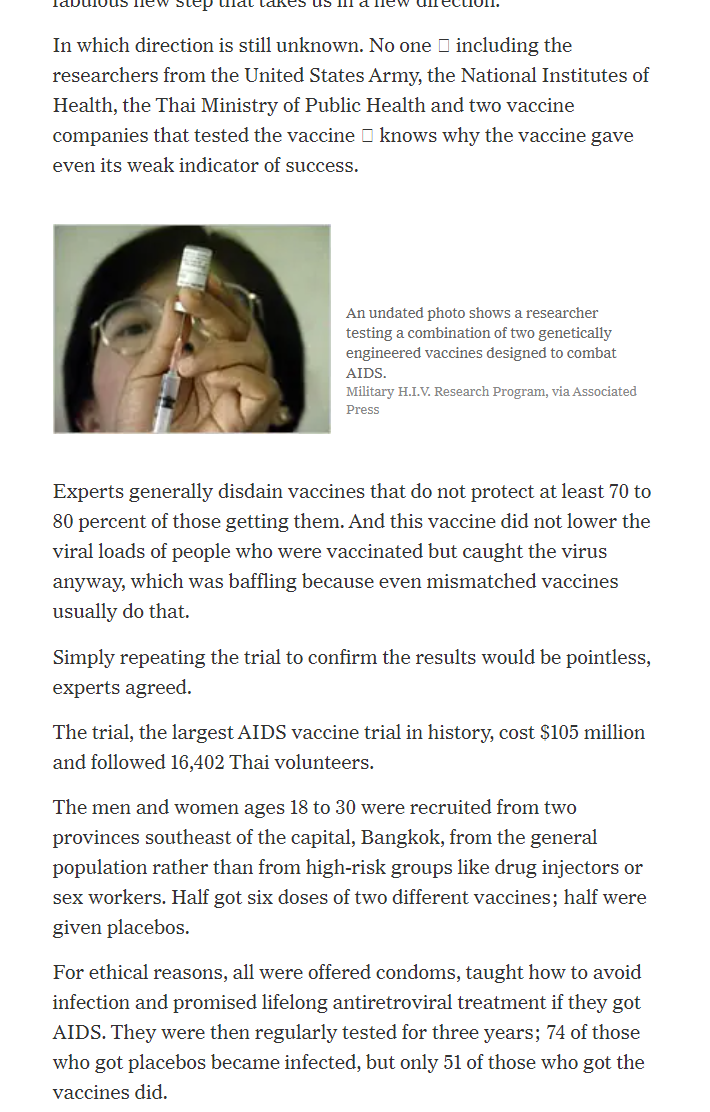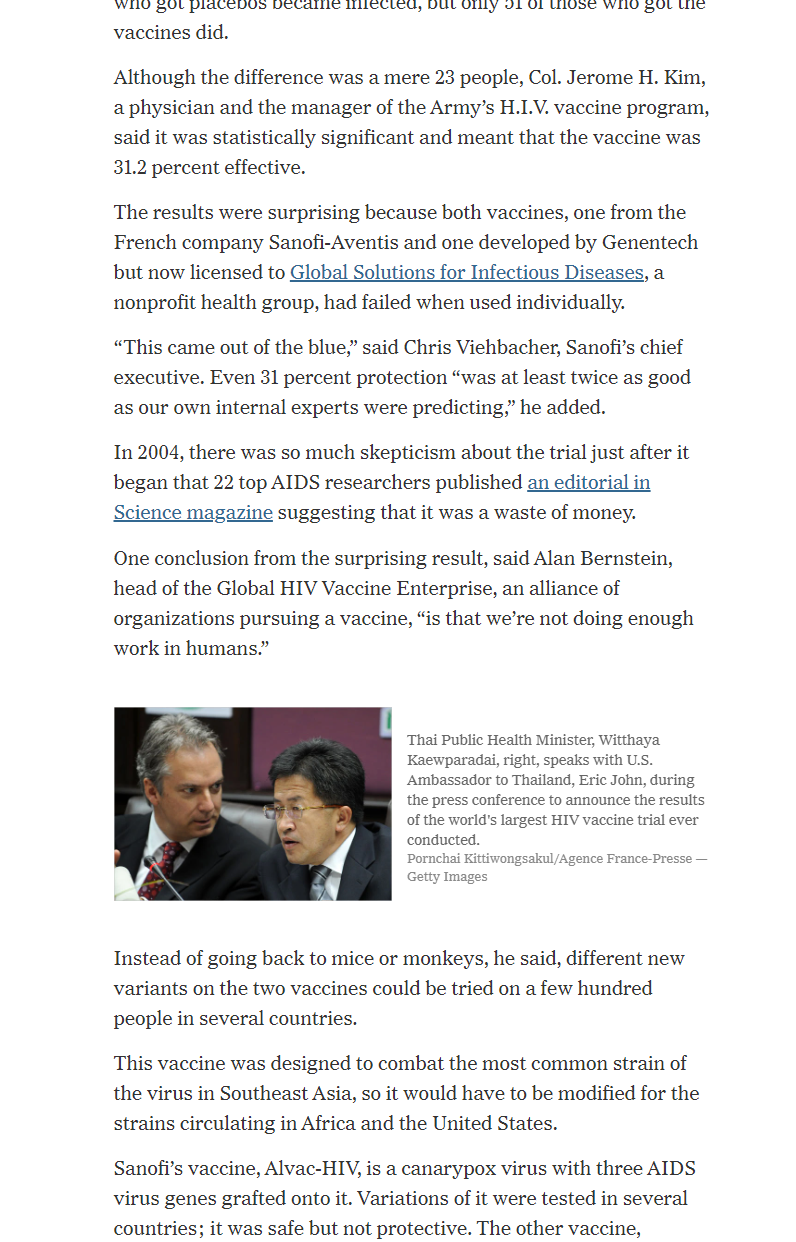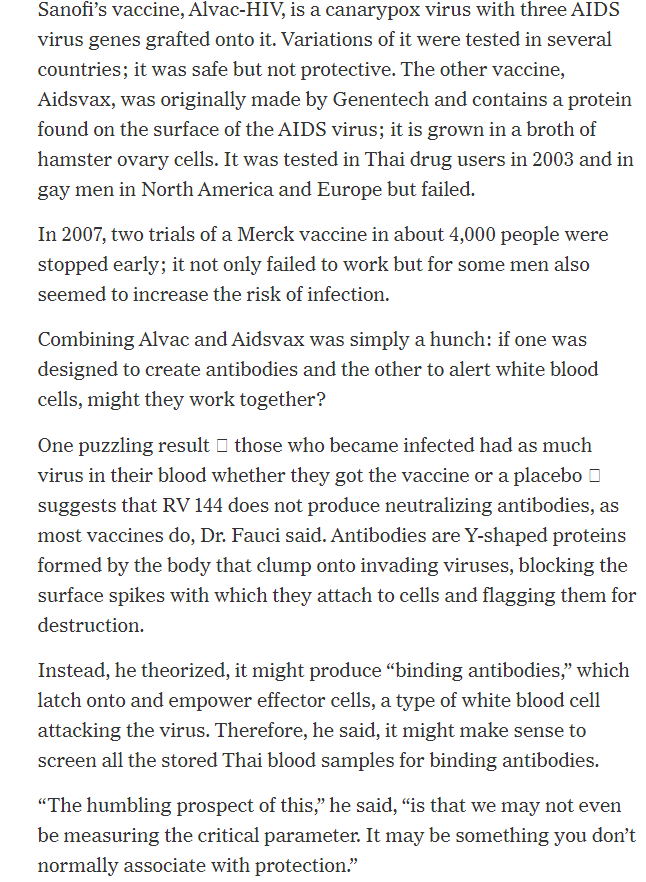3|]: New ork aims For First Time, AIDS Vaccine Shows Some Success By Donald G. McNeil Jr. Sept. 24,2009 f i l "i D Scientists said Thursday that a new AIDS vaccine, the rst ever declared to protect a signicant minority of humans against the disease, would be studied to answer two fundamental questions: why it worked in some people but not in others, and why those infected despite vaccination got no benet at all. The vaccine III known as RV 144, a combination of two genetically engineered vaccines, neither of which had worked before in humans 3 was declared a qualied success after a six-year clinical trial on more than 16,000 volunteers in Thailand. Those who were vaccinated became infected at a rate nearly one-third lower than the others, the sponsors said Thursday morning. \"I don't want to use a word like 'breakthrough,' but I don't think there's any doubt that this is a very important resul ,\" said Dr. Anthony S. Fauci, the director of the National Institute of Allergy and Infectious Diseases, which is one of the trial's backers. \"For more than 20 years now, vaccine trials have essentially been failures,\" Dr. Fauci said. \"Now it's like we were groping down an unlit path, and a door has been opened. We can start asking some very important questions.\" It will still, however, take years of work before a vaccine that could end the epidemic, which has killed about 25 million people, can even be contemplated. \"We often talk about whether a vaccine is even possible,\" said Mitchell Warren, the executive director of the AIDS Vaccine Advocacy Coalition, or AVAC. \"This is not the vaccine that ends the epidemic and says, '0.K., let's move on to something else.' But it's a fabulous new step that takes us in a new direction.\" In which direction is still unknown. No one _ including the researchers from the United States Army, the National Institutes of Health, the Thai Ministry of Public Health and two vaccine companies that tested the vaccine _ knows why the vaccine gave even its weak indicator of success. An undated photo shows a researcher testing a combination of two genetically engineered vaccines designed to combat AIDS. Military H.I.V. Research Program, via Associated Press Experts generally disdain vaccines that do not protect at least 70 to 80 percent of those getting them. And this vaccine did not lower the viral loads of people who were vaccinated but caught the virus anyway, which was baffling because even mismatched vaccines usually do that. Simply repeating the trial to confirm the results would be pointless, experts agreed. The trial, the largest AIDS vaccine trial in history, cost $105 million and followed 16,402 Thai volunteers. The men and women ages 18 to 30 were recruited from two provinces southeast of the capital, Bangkok, from the general population rather than from high-risk groups like drug injectors or sex workers. Half got six doses of two different vaccines; half were given placebos. For ethical reasons, all were offered condoms, taught how to avoid infection and promised lifelong antiretroviral treatment if they got AIDS. They were then regularly tested for three years; 74 of those who got placebos became infected, but only 51 of those who got the vaccines did.who got placebos vaccines did. Although the difference was a mere 23 people, Col. Jerome H. Kim, a physician and the manager of the Army's H.I.V. vaccine program, said it was statistically significant and meant that the vaccine was 31.2 percent effective. The results were surprising because both vaccines, one from the French company Sanofi-Aventis and one developed by Genentech but now licensed to Global Solutions for Infectious Diseases, a nonprofit health group, had failed when used individually. "This came out of the blue," said Chris Viehbacher, Sanofi's chief executive. Even 31 percent protection "was at least twice as good as our own internal experts were predicting," he added. In 2004, there was so much skepticism about the trial just after it began that 22 top AIDS researchers published an editorial in Science magazine suggesting that it was a waste of money. One conclusion from the surprising result, said Alan Bernstein, head of the Global HIV Vaccine Enterprise, an alliance of organizations pursuing a vaccine, "is that we're not doing enough work in humans." Thai Public Health Minister, Witthaya Kaewparadai, right, speaks with U.S. Ambassador to Thailand, Eric John, during the press conference to announce the results of the world's largest HIV vaccine trial ever conducted. Pornchai Kittiwongsakul/Agence France-Presse - Getty Images Instead of going back to mice or monkeys, he said, different new variants on the two vaccines could be tried on a few hundred people in several countries. This vaccine was designed to combat the most common strain of the virus in Southeast Asia, so it would have to be modified for the strains circulating in Africa and the United States. Sanofi's vaccine, Alvac-HIV, is a canarypox virus with three AIDS virus genes grafted onto it. Variations of it were tested in several countries; it was safe but not protective. The other vaccine,Sanofi's vaccine, Alvac-HIV, is a canarypox virus with three AIDS virus genes grafted onto it. Variations of it were tested in several countries; it was safe but not protective. The other vaccine, Aidsvaz, was originally made by Genentech and contains a protein found on the surface of the AIDS virus; it is grown in a broth of hamster ovary cells. It was tested in Thai drug users in 2003 and in gay men in North America and Europe but failed. In 200?, two trials of a Merck vaccine in about 4,000 people were stopped early; it not only failed to work but for some men also seemed to increase the risk of infection. Combining Alvac and Aidsvaa was simply a hunch: if one was designed to create antibodies and the other to alert white blood cells, might they work together? One puzzling result D those who became infected had as much virus in their blood whether they got the vaccine or a placebo ] suggests that RV 144 does not produce neutralizing antibodies, as most vaccines do, Dr. Fauci said. Antibodies are Yshaped proteins formed by the body that clump onto invading viruses, blocking the surface spikes with which they attach to cells and flagging them for destruction. Instead, he theorized, it might produce \"binding antibodies,\" which latch onto and empower effector cells, a type of white blood cell attacking the virus. Therefore, he said, it might make sense to screen all the stored Thai blood samples for binding antibodies. \"The humbling prospect of this,\" he said, \"is that we may not even be measuring the critical parameter. It may be something you don't normally associate with protection.\" florinfamily associate with protection. Dr. Lawrence Corey, the principal investigator for the HIV Vaccine Trials Network, who was not part of the RV 144 trial, said new work on weakened versions of the smallpox vaccine had produced better pox "spines" that could be substituted for the canarypox. New trials, he added, could be faster and smaller if they were done in African countries where AIDS is more common than in Thailand. A version of this article appears in print on Sept. 25, 2009, Section A, Page 1 of the New York edition with the headline- Vaccine for AIDS Passes Trial. Limits of Success to Be Studied Order Reprints IToday's Paper I Subscribe











